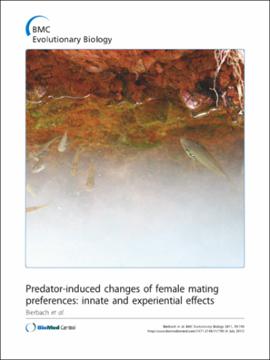| dc.contributor.author | Bierbach, David | |
| dc.contributor.author | Schulte, Matthias | |
| dc.contributor.author | Herrmann, Nina | |
| dc.contributor.author | Tobler, Michael | |
| dc.contributor.author | Stadler, Stefan | |
| dc.contributor.author | Jung, Christian T. | |
| dc.contributor.author | Kunkel, Benjamin | |
| dc.contributor.author | Riesch, Rudiger | |
| dc.contributor.author | Klaus, Sebastian | |
| dc.contributor.author | Ziege, Madlen | |
| dc.contributor.author | Indy, Jeane Rimber | |
| dc.contributor.author | Arias-Rodriguez, Lenin | |
| dc.contributor.author | Plath, Martin | |
| dc.date.accessioned | 2018-11-09T21:10:55Z | |
| dc.date.available | 2018-11-09T21:10:55Z | |
| dc.date.issued | 2011-07-04 | |
| dc.identifier | oksd_bierbach_predator-induce_2011-07-04 | |
| dc.identifier.citation | Bierbach, D., Schulte, M., Herrmann, N., Tobler, M., Stadler, S., Jung, C. T., ... Plath, M. (2011). Predator-induced changes of female mating preferences: Innate and experiential effects. BMC Evolutionary Biology, 11, Article 190. https://doi.org/10.1186/1471-2148-11-190 | |
| dc.identifier.uri | https://hdl.handle.net/11244/302072 | |
| dc.description.abstract | Background: In many species males face a higher predation risk than females because males display elaborate traits that evolved under sexual selection, which may attract not only females but also predators. Females are, therefore, predicted to avoid such conspicuous males under predation risk. The present study was designed to investigate predator-induced changes of female mating preferences in Atlantic mollies (Poecilia mexicana). Males of this species show a pronounced polymorphism in body size and coloration, and females prefer large, colorful males in the absence of predators. | |
| dc.description.abstract | Results: In dichotomous choice tests predator-naive (lab-reared) females altered their initial preference for larger males in the presence of the cichlid Cichlasoma salvini, a natural predator of P. mexicana, and preferred small males instead. This effect was considerably weaker when females were confronted visually with the non-piscivorous cichlid Vieja bifasciata or the introduced non-piscivorous Nile tilapia (Oreochromis niloticus). In contrast, predator experienced (wild-caught) females did not respond to the same extent to the presence of a predator, most likely due to a learned ability to evaluate their predators' motivation to prey. | |
| dc.description.abstract | Conclusions: Our study highlights that (a) predatory fish can have a profound influence on the expression of mating preferences of their prey (thus potentially affecting the strength of sexual selection), and females may alter their mate choice behavior strategically to reduce their own exposure to predators. (b) Prey species can evolve visual predator recognition mechanisms and alter their mate choice only when a natural predator is present. (c) Finally, experiential effects can play an important role, and prey species may learn to evaluate the motivational state of their predators. | |
| dc.format | application/pdf | |
| dc.language | en_US | |
| dc.publisher | BioMed Central | |
| dc.rights | This material has been previously published. In the Oklahoma State University Library's institutional repository this version is made available through the open access principles and the terms of agreement/consent between the author(s) and the publisher. The permission policy on the use, reproduction or distribution of the material falls under fair use for educational, scholarship, and research purposes. Contact Digital Resources and Discovery Services at lib-dls@okstate.edu or 405-744-9161 for further information. | |
| dc.title | Predator-induced changes of female mating preferences: Innate and experiential effects | |
| osu.filename | oksd_bierbach_predator-induce_2011-07-04.pdf | |
| dc.description.peerreview | Peer reviewed | |
| dc.identifier.doi | 10.1186/1471-2148-11-190 | |
| dc.description.department | Zoology | |
| dc.type.genre | Article | |
| dc.type.material | Text | |
| dc.subject.keywords | sexual selection | |
| dc.subject.keywords | female choice | |
| dc.subject.keywords | non-independent mate choice | |
| dc.subject.keywords | predator recognition | |
| dc.subject.keywords | poecilia mexicana | |
